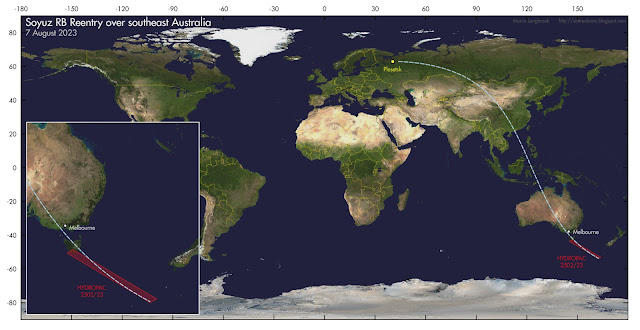 |
| Click map to enlarge |
UPDATE (24 Aug 2023)
The launch took place around 18:50 UTC (so at nighttime this time) on August 23. The payload failed to reach orbit.
According to the North Korean State News Agency KCNA, the first and second stages worked nominally (the second stage failed during the May launch), but there was an "error in the emergency blasting system during the third-stage flight".
This sounds like the self-destruct mechanism was triggered by mistake.
KCNA reports that a third launch attempt will be conducted in October. Apparently, they have a lot of spare satellites and rockets in store...
[end of update]
North Korea has issued a Navigational Warning for a new satellite launch attempt from Sohae. The launch window runs from 23 August 15:00 UTC to 30 August 15:00 UTC.
The three hazard areas from HYDROPAC 2699/23 (blue in the map above) are similar to those for the failed June launch attempt. They are different from the 2016 KMS-4 launch (shown in red in the map above, for comparison)
(more on the failed June attempt in a previous post here, which also discusses the two possible launch trajectories I have depicted in the map).
The text of Navigational Warning HYDROPAC 2699/23:
211953Z AUG 23
HYDROPAC 2699/23(91,92,94).
PHILIPPINE SEA.
YELLOW SEA.
CHINA.
DNC 11, DNC 23.
1. HAZARDOUS OPERATIONS, ROCKET LAUNCHING
231500Z TO 301500Z AUG IN AREAS BOUND BY:
A. 36-06.94N 123-33.11E, 35-24.52N 123-22.78E,
35-20.02N 123-48.62E, 36-02.44N 123-59.18E.
B. 34-05.90N 123-01.99E, 33-23.47N 122-51.88E,
33-16.54N 123-29.66E, 33-58.97N 123-40.07E.
C. 14-54.17N 128-40.10E, 11-19.30N 129-10.84E,
11-26.81N 129-54.13E, 15-01.70N 129-24.05E.
2. CANCEL THIS MSG 301600Z AUG 23.
